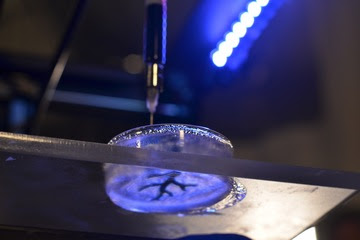Organs on Demand : 3D Printers Could Build Hearts, Arteries
Off-the-shelf 3D printers could one day help create living organs to aid in repairing the human body, researchers say.
Scientists have developed a way to 3D print models of various anatomical structures, including hearts, brains, arteries and bones. In the future, this process could be used to create 3D-printed soft implants in which living tissue can grow to form organs. Another application for this innovative technology could be food printers, reminiscent of the replicators seen on the TV show "Star Trek," the scientists added.
Scientists have developed a way to 3D print models of various anatomical structures, including hearts, brains, arteries and bones. In the future, this process could be used to create 3D-printed soft implants in which living tissue can grow to form organs. Another application for this innovative technology could be food printers, reminiscent of the replicators seen on the TV show "Star Trek," the scientists added.
A 3D printer is a machine that creates items from a wide variety of materials: plastic, ceramic, glass, metal and even more unusual ingredients, such as living cells. The device works by depositing layers of material, just as ordinary printers lay down ink, except 3D printers can also lay down flat layers on top of each other to build 3D objects. [7 Cool Uses of 3D Printing in Medicine]
Conventional 3D printers manufacture objects from rigid materials, with each layer receiving a sturdy foundation from the layers below. However, printing soft materials has proven to be difficult, akin to building an object out of Jell-O.
"Metals, ceramics and stiff polymers have been 3D printed for many, many years, but soft materials, those that can deform under their own weight, have been more challenging to support during the print process," said Adam Feinberg, a biomedical engineer at Carnegie Mellon University and senior author of the new study.
Researchers have used 3D printers to create rigid medical devices customized for individual patients; those devices include hearing aids, dental implants and prosthetic hands. However, using 3D printers to create soft implants, a process known as bioprinting, could provide alternatives to traditional transplants for repairing or replacing damaged organs, Feinberg said.
"The potential applications we envision are in the area of tissue engineering — essentially, 3D printing scaffolds and cells to regrow tissues and organs," Feinberg told Live Science.
The scientists have developed a way of 3D printing soft materials inside a bath of supportive fluid that contains gelatin powder, similar to the type that can be found in a supermarket.
"We print one gel inside of another gel, which allows us to accurately position the soft material as it's being printed, layer by layer," Feinberg said in a statement.
Using medical imaging data, the researchers used their new technique, called FRESH, or "Freeform Reversible Embedding of Suspended Hydrogels," to print simplified, proof-of-concept anatomical structures. These were made of a variety of biological materials, such as the collagen found in tendons and ligaments. The test structures included a human femur, a human coronary artery, a five-day embryonic chick heart and the external folds of a human brain. [5 Crazy Technologies That Are Revolutionizing Biotech]
The models were printed with a resolution of about 200 microns, the researchers said. (In comparison, the average human hair is about 100 microns wide.)
"We can take materials like collagen, fibrin and alginate, which are the types of materials the body uses to build itself, and 3D print them," Feinberg said. "We can now build tissue-engineering scaffolds using these materials in incredibly complex structures that more closely match those of real tissues and organs in the body." (Fibrin helps make up blood clots, while alginate is found in many seaweeds.)
In this new technique, the support gel around the 3D structures can be easily melted away and removed by heating it to body temperature. Such temperatures would not damage any delicate biological molecules or living cells printed out in the method, the scientists said.
The researchers cautioned that they have not yet bioprinted organs. "This work is an important step in that direction by enabling us to use biological materials that we believe are necessary to do this," Feinberg said. "However, years of research are still required."
In the future, the researchers plan to incorporate real heart cells into their work, they said. The 3D-printed structures will serve as scaffolds in which the cells can grow and form heart muscle.
Bioprinting living cells is a growing field, but, until now, most 3D bioprinters retailed for more than $100,000, or required specialized expertise to operate (or both), limiting the possibilities for the technique's widespread adoption. However, this new method can be done with consumer-level 3D printers that cost less than $1,000. It also uses open-source software that the researchers say they invite others to hack and improve.
"Our vision is that other research groups can take this technology and apply it broadly to other tissue-engineering and soft-materials 3D-printing challenges," Feinberg said.
The scientists detailed their findings online today (Oct. 23) in the journal Science Advances.


